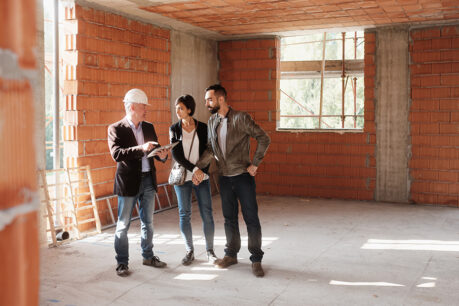
Disclaimer: This content may include information about products, features, and/or services that The Federal Savings Bank does not provide and is intended to be educational in nature.
Searching the market for your dream home can leave you with a long trail of unchecked boxes. When you have a vivid vision for the place you’ll call home, sometimes the best way to make it a reality is to build it. So, how do you do that?
There are many options for home construction lending, all with distinct features. Among those options, government-backed construction loans stand out for their unique benefits for eligible borrowers. In this article, we will explain what government-backed construction loans are, how they work, and the three most prominent government home loan options you may come across.
Explaining Government-Backed Construction Loans
Government-backed construction loans differ from conventional construction loans in a few key ways, but most notably, they are a type of loan that is insured or guaranteed by a federal government agency. It’s important to note that the loans themselves are not coming from the federal government, but rather, borrowers apply for them through private lenders that offer that loan type.
The agency’s role in that transaction is to reduce the risk for lenders, so eligible borrowers can achieve their goal of homeownership. For example, if you were to default on your Federal Housing Administration (FHA) construction loan, the FHA would pay the lender the insured amount. Of course, you could risk losing your home in that situation.
When the lender knows they can recoup some of the value of the loan via the agency, they are more willing to offer competitive rates and credit requirements. Essentially, a government-backed construction loan can make homebuilding more accessible for eligible borrowers than many conventional loan options.
What Kind of Government-Backed Construction Are Available?
When considering a government-backed construction loan, you will typically look at one of the following, depending on the offerings of your lender, of course:
Federal Housing Administration (FHA) Construction Loans
An FHA construction loan works similarly to a conventional construction loan. It provides short-term financing through the construction period, then converts to a long-term mortgage once the home is built. However, FHA construction loans are insured by the FHA. Borrowers must meet the FHA’s guidelines to be eligible for this type of loan. Lenders will also set their own requirements.
Generally, a borrower for an FHA loan will:
- Put down a 3.5% minimum down payment.
- Have a minimum credit score of 580 (though lenders may set higher minimums on FHA construction loans.
- Intend to use the property as their primary residence.
Borrowers may gravitate toward FHA construction loans if they want to put down a lower down payment or have a lower credit score.
Veterans Affairs (VA) Construction Loans
A VA construction loan is a specialized loan option designed for eligible veterans, active-duty service members and certain military spouses who want to build a new home. It can cover a wide range of expenses related to your construction project, and it often offers favorable terms for borrowers. These include:
- No down payment requirements
- Competitive interest rates
- No private mortgage insurance (PMI)
However, when you use a VA loan, you must meet the VA’s requirements. Your lender can help you with this, but one thing to note is that your home build must meet VA minimum property requirements. These are in place to ensure veteran borrowers are moving into safe, livable homes. The borrower must also intend to use the property as their primary residence.
If you are an eligible veteran, want to minimize upfront costs, plan to work with a VA-approved builder, and want to take advantage of 100% financing, VA construction loans could be a good option.
United States Department of Agriculture (USDA) Construction Loans
USDA construction loans can be a smart choice for low-to-moderate income borrowers who want to build their home in eligible rural or suburban areas. As with the other government-backed construction loan types mentioned above, this loan is backed by a federal agency (the USDA) and is designed to help eligible borrowers make homeownership a reality.
To be eligible for a USDA construction loan, you must:
- Have an income that does not exceed 115% of median household income.
- Intend to occupy the home as your primary residence.
- Be a U.S. citizen, non-citizen national, or Qualified Alien.
These loans typically do not require a downpayment or PMI and can accommodate borrowers with lower credit scores (usually 640 or above). If you are eligible for a USDA construction loan and interested in the slow-living lifestyle of a rural community, this may be worth discussing with an approved lender.
How Do Government-Backed Construction Loans Work?
There may be some varieties of loan structures depending on the lender. One common structure is the two-time close. This means the loan process takes place across two separate phases.
First, you secure a short-term construction loan to finance the building of the home. During this phase, funds are distributed on a draw schedule based on project milestones, such as foundation completion. Lender-mandated inspections are conducted at each stage to ensure the project is meeting necessary standards.
Then, after construction is done, a second closing occurs. At that closing, the original loan converts into a traditional government-backed mortgage. This permanent home loan pays off the construction financing and becomes your long-term mortgage. Finally, you get to move in and enjoy your dream home!
Are You Ready to Start Building?
For many borrowers, government-backed construction loans can be the best way to get their dream home out of their head and into the world. If you know you want to build a home and that you meet the eligibility criteria for the FHA, VA, or USDA, you may want to speak to a lender experienced in these kinds of loans.
The Federal Savings Bank has a long track record of navigating through the construction loan process. When you’re ready to make your dream home a reality, or to learn more about the process, reach out!
This information is intended for educational purposes only. Products and interest rates subject to change without notice. Loan products are subject to credit approval and include terms and conditions, fees and other costs. Terms and conditions may apply. Property insurance is required on all loans secured by property. VA loan products are subject to VA eligibility requirements. Adjustable Rate Mortgage (ARM) interest rates and monthly payment are subject to adjustment. Upon submission of a full application, a mortgage banker will review and provide you with the terms, conditions, disclosures, and additional details on the interest rates that apply to your individual situation.


